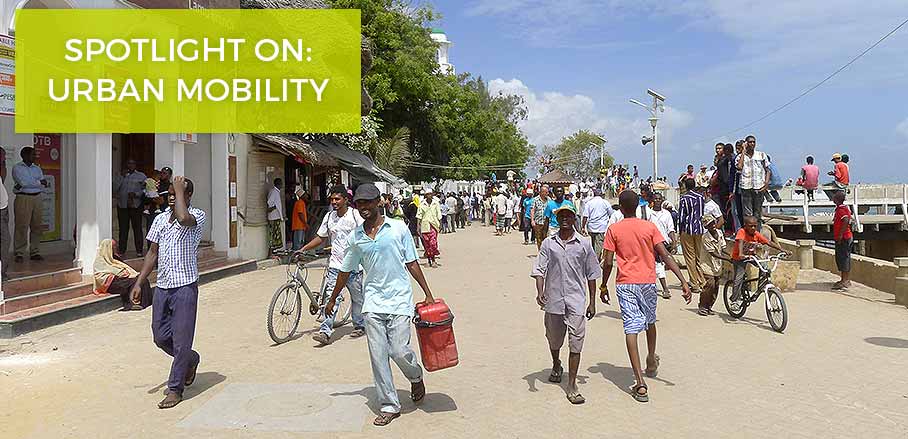How sustainable mobility can transform Africa’s cities
Over the next 15 years, African cities will add 300 million new urban residents—fully two-thirds above today’s urban population[1]http://www.un.org/en/development/desa/population/publications/pdf/trends/Population2030.pdf. This unprecedented demographic shift presents a tremendous opportunity for economic uplift and poverty reduction, but these benefits hinge on the ability of African cities to dramatically improve the delivery of infrastructure and services to drive future growth.
Today, cities in Africa struggle to manage rapidly growing populations. Sprawling development patterns push new housing development far from people’s jobs, resulting in longer and longer commute times. Despite heavy investment in road infrastructure in major cities, traffic congestion is a daily challenge, turning a 10-kilometre commute into a 3-hour ordeal. New and wider roads simply invite more commuters to start using private cars. Congestion thus worsens to the same level as before the expansion—but with even more commuters stuck in traffic. Unfortunately, planning efforts and investments continue to focus on building roads and highways that will only benefit the small elite that uses personal vehicles[2]http://www.businessdailyafrica.com/World-Bank-deal-paves-way-for-work-on-Nairobi/539546-3336854-140aedl/index.html, https://www.afdb.org/en/news-and-events/african-development-bank-group-approves-loan-to-improve-urban-transport-in-abidjan-16585/, http://pulse.ng/traffic/traffic-gridlocks-lagos-state-government-to-decongest-roads-with-highway-expansion-id4987646.html. These projects, if pursued, will lock African cities into a car-dependent future, with rising numbers of car accidents, congestion, and air pollution.
Cities need to move towards mass transport systems
To address these challenges, African cities urgently need to expand access to sustainable mobility modes. With 40 to 60 percent of trips taken by foot, cities require extensive networks of well-designed facilities. Yet too many roads are designed only for cars, with little thought given to the need for facilities for all users, including footpaths and accessible infrastructure[3]https://www.standardmedia.co.ke/article/2001235677/perils-of-being-a-pedestrian-on-nairobi-roads. The result is unacceptable carnage from road accidents—for instance, in Nairobi pedestrians account for a full 70 percent of road fatalities[4]http://www.kara.or.ke/Nairobi%20City%20County%20Non%20Motorized%20Transport%20Policy.pdf. Pedestrians often have little space to walk at the side of the road and are sent onto footbridges to cross the street. Given the inconvenience involved, it is little wonder that pedestrians avoid such bridges and instead seek out the shortest path to their destinations. The Nairobi Accident Map indicates that 43 percent of collisions involving a pedestrian happened within 500 metres of a footbridge[5]https://nairobiaccidentmap.com/2017/03/22/pedestrians-footbridges-2/.
For those who can afford motorised transport, informal minibuses serve as the backbone of the transport system, providing essential mobility in the absence of government-run public transport. Yet these services are inconsistent and unreliable, and most users hope to switch to driving a car as soon as they have the economic resources to do so. Although informal public transport users account for the majority of commuters on arterial corridors, minibuses are forced to compete with other modes of transport for road space. As a result, access through public transport is severely restrained. In Nairobi, bus users can reach only 10 percent of all jobs within 45 minutes, compared to 60 percent of jobs for people who have cars[6]https://openknowledge.worldbank.org/bitstream/handle/10986/25896/211044ov.pdf. With limited road space available, African cities need to prioritise the modes that make most efficient use of road space. An important solution in this respect is bus rapid transit (BRT)—a high-quality bus-based rapid transit system with median lanes that are dedicated for buses. BRT systems feature elements that deliver high performance, such as stepless boarding, off-board fare collection, and intersection improvements[7]http://www.brtstandard.org. As a result of these features, BRT offers high-capacity, high-quality service at a fraction of the cost of rail-based forms of mass rapid transit.
In Dar es Salaam, the newly inaugurated Dar Rapid Transit (DART) BRT system already carries 160,000 passengers every day, a figure that is slated to rise to 400,000 once the first phase is fully operational[8]https://www.itdp.org/dar-es-salaams-dart/. DART has resulted in dramatic time savings, cutting two-hour commutes from Kimara to the city centre to a mere 45 minutes[9]https://www.youtube.com/watch?v=a_V29yVYqGo. Over the next 15 years, African cities will need hundreds of kilometres of high-capacity BRT to provide better access for urban residents.
Choosing a different path towards compact and inclusive development
As cities expand access to high-quality BRT, land use regulations must be reformed to encourage compact development along rapid transit corridors. Decisions about urban development have long-term, and almost irreversible, consequences. The dispersed development patterns seen today in Accra, Dar es Salaam, Kigali, and other African cities inhibit access to public transport and raise the cost of providing essential services such as water, sewage treatment, and electricity. Planning regulations that prevent compact development in city centres contribute to the proliferation of informal settlements, with the fraction of residents living in informal housing running as high as 70 percent in cities such as Dar es Salaam[10]https://www.citylab.com/design/2015/02/the-bright-future-of-dar-es-salaam-an-unlikely-african-megacity/385801/.
As an alternative to continued automobile-oriented sprawl that segregates people and land uses, African cities can choose a different path of promoting compact and inclusive development. Inclusive transit-oriented development (TOD) features compact, pedestrian-friendly neighbourhoods; a mix of affordable housing, diverse jobs and services; and high-quality rapid transit connections to other parts of the city[11]http://www.todstandard.org. In order to achieve this vision, cities need to reform regulations that limit compact development (e.g., low caps on built up area and ground coverage; setback requirements; and minimum off-street parking standards). Zoning rules must be reformed to permit a mix of uses and to encourage the development of small, low-cost units within walking distance of rapid transit corridors. In the long run, TOD policies will not only improve social equity, but will also reduce energy use, save infrastructure costs, and cut greenhouse gas emissions.
